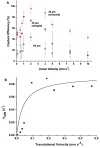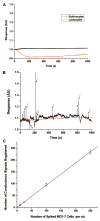Highly efficient circulating tumor cell isolation from whole blood and label-free enumeration using polymer-based microfluidics with an integrated conductivity sensor
- PMID: 18557614
- PMCID: PMC2526315
- DOI: 10.1021/ja8015022
Highly efficient circulating tumor cell isolation from whole blood and label-free enumeration using polymer-based microfluidics with an integrated conductivity sensor
Abstract
A novel microfluidic device that can selectively and specifically isolate exceedingly small numbers of circulating tumor cells (CTCs) through a monoclonal antibody (mAB) mediated process by sampling large input volumes (>/=1 mL) of whole blood directly in short time periods (<37 min) was demonstrated. The CTCs were concentrated into small volumes (190 nL), and the number of cells captured was read without labeling using an integrated conductivity sensor following release from the capture surface. The microfluidic device contained a series (51) of high-aspect ratio microchannels (35 mum width x 150 mum depth) that were replicated in poly(methyl methacrylate), PMMA, from a metal mold master. The microchannel walls were covalently decorated with mABs directed against breast cancer cells overexpressing the epithelial cell adhesion molecule (EpCAM). This microfluidic device could accept inputs of whole blood, and its CTC capture efficiency was made highly quantitative (>97%) by designing capture channels with the appropriate widths and heights. The isolated CTCs were readily released from the mAB capturing surface using trypsin. The released CTCs were then enumerated on-device using a novel, label-free solution conductivity route capable of detecting single tumor cells traveling through the detection electrodes. The conductivity readout provided near 100% detection efficiency and exquisite specificity for CTCs due to scaling factors and the nonoptimal electrical properties of potential interferences (erythrocytes or leukocytes). The simplicity in manufacturing the device and its ease of operation make it attractive for clinical applications requiring one-time use operation.
Figures





Similar articles
-
Nanostructure embedded microchips for detection, isolation, and characterization of circulating tumor cells.Acc Chem Res. 2014 Oct 21;47(10):2941-50. doi: 10.1021/ar5001617. Epub 2014 Aug 11. Acc Chem Res. 2014. PMID: 25111636 Free PMC article. Review.
-
Nanoroughened adhesion-based capture of circulating tumor cells with heterogeneous expression and metastatic characteristics.BMC Cancer. 2016 Aug 8;16:614. doi: 10.1186/s12885-016-2638-x. BMC Cancer. 2016. PMID: 27501846 Free PMC article.
-
UV activation of polymeric high aspect ratio microstructures: ramifications in antibody surface loading for circulating tumor cell selection.Lab Chip. 2014 Jan 7;14(1):106-17. doi: 10.1039/c3lc50618e. Lab Chip. 2014. PMID: 23900277 Free PMC article.
-
Poly(ethylene oxide) Concentration Gradient-Based Microfluidic Isolation of Circulating Tumor Cells.Anal Chem. 2023 Feb 14;95(6):3468-3475. doi: 10.1021/acs.analchem.2c05257. Epub 2023 Feb 1. Anal Chem. 2023. PMID: 36725367
-
[Recent advances in isolation and detection of circulating tumor cells with a microfluidic system].Se Pu. 2022 Mar 8;40(3):213-223. doi: 10.3724/SP.J.1123.2021.07009. Se Pu. 2022. PMID: 35243831 Free PMC article. Review. Chinese.
Cited by
-
Enzymatic cleavage of uracil-containing single-stranded DNA linkers for the efficient release of affinity-selected circulating tumor cells.Chem Commun (Camb). 2015 Feb 21;51(15):3266-9. doi: 10.1039/c4cc09765c. Chem Commun (Camb). 2015. PMID: 25616078 Free PMC article.
-
Herceptin functionalized microfluidic polydimethylsiloxane devices for the capture of human epidermal growth factor receptor 2 positive circulating breast cancer cells.Biomicrofluidics. 2010 Sep 30;4(3):32205. doi: 10.1063/1.3480573. Biomicrofluidics. 2010. PMID: 21045921 Free PMC article.
-
Liquid Biopsy: The Unique Test for Chasing the Genetics of Solid Tumors.Epigenet Insights. 2020 Feb 28;13:2516865720904052. doi: 10.1177/2516865720904052. eCollection 2020. Epigenet Insights. 2020. PMID: 32166219 Free PMC article. Review.
-
Nanostructure embedded microchips for detection, isolation, and characterization of circulating tumor cells.Acc Chem Res. 2014 Oct 21;47(10):2941-50. doi: 10.1021/ar5001617. Epub 2014 Aug 11. Acc Chem Res. 2014. PMID: 25111636 Free PMC article. Review.
-
Isolation and retrieval of circulating tumor cells using centrifugal forces.Sci Rep. 2013;3:1259. doi: 10.1038/srep01259. Epub 2013 Feb 12. Sci Rep. 2013. PMID: 23405273 Free PMC article.
References
Publication types
MeSH terms
Substances
Grants and funding
LinkOut - more resources
Full Text Sources
Other Literature Sources
Miscellaneous

